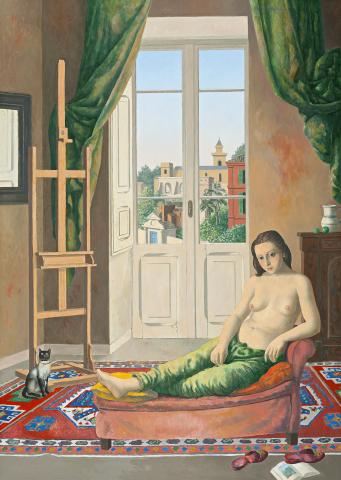INTERIOR WITH FIGURE ON A SOFA, c.1986
JUSTIN O'BRIEN
oil on canvas
94.0 x 66.5 cm
signed upper right: O’BRIEN
Cooks Hill Galleries, Newcastle
Private collection
Savill Galleries, Melbourne (label attached verso)
Private collection, Tasmania
120 Years of Australian Painting,Savill Galleries, South Yarra, 3 September – 1 October 2000, cat. 37 (illus. in exhibition catalogue)
Figure on a Sofa, 1986, oil on canvas, 58.0 x 62.0 cm, private collection, illus. France. C., Justin O’Brien: Image and Icon, Craftsman House, New South Wales, 1987, pl. 29, p. 91
Possessing the form and beauty of a Renaissance composition, Interior with Figure on a Sofa, c.1986 is a lyrical example of Justin O’Brien’s use of colour and technique. The painting immediately conjures vision of Titian’s masterpiece Venus of Urbino, 1538, in the collection of the Uffizi Gallery, Florence. There are numerous similarities between the picture on offer and Titian’s painting, as O’Brien pays homage to a work that has inspired many tributes, including Edouard Manet’s Olympia, 1863, in the collection of the Musée d’Orsay, Paris. Like Venus, O’Brien’s model Daniela Scardamaglia – who also appears in the related work Figure on a Sofa, 1986 – reclines on a soft red sofa and gazes into the eyes of the viewer.1 The position of her hands and legs mimics the pose of the Roman goddess, and in both paintings, sumptuous dark green drapes frame the composition whilst a window provides a glimpse of the outside surrounds. In Titian’s painting, a small dog rests at the end of the sofa, but in the picture on offer, the dog is replaced by a small, alert cat seated on the carpet, making reference to the black cat in Manet’s Olympia. Whilst there are similarities to Manet’s painting, O’Brien’s muse does not exude the unabashed confidence of Manet’s concubine; rather she reflects the composure of Titian’s goddess. There is a delicate sensuality to the naturalistic form of the young woman as O’Brien pays deference to the human body and the Italian masters.
Details from Interior with Figure on a Sofa, c.1986 reappear in O’Brien’s related work Figure on a Sofa, 1986. A common occurrence throughout his oeuvre, the artist frequently replicated scenes and details across numerous works. Both paintings are set in the same room featuring a patterned rug, sofa, a white jug and two apples placed on top of a mantelpiece, and Daniela’s book and slippers that lie nonchalantly on the floor. The picture on offer is bathed in sunlight, illuminating an empty painting easel that sits in the corner, patiently waiting for the masterpiece to emerge as if the viewer has taken the role of artist. The open windows allow O’Brien to include a view of the outside landscape, creating dual scenes in the one composition. Revealing a picturesque skyline, the cityscape most likely depicts Rome where O’Brien resided from 1967 until his death in 1996. O’Brien delighted in creating two realities within the one scene. Often these would reflect a realistic view versus a painted version, or a spiritual scene versus a secular. Here, O’Brien challenges the visual beauty between the perfectly poised model and the splendour of the city.
Interior with Figure on a Sofa, c.1986 demonstrates the rich tapestry of colour for which O’Brien is renowned. His controlled but brilliant application of paint cemented O’Brien’s reputation as a master of colour; as the artist and critic, James Gleeson, commented after viewing O’Brien’s exhibition at Macquarie Galleries in 1950, ‘O’Brien uses colour as a composer uses sound.’2
1. France, C., Justin O’Brien: Image and Icon, Craftsman House, Sydney, 1987, p. 28
2. Pearce, B., and Wilson, N. Justin O’Brien: The Sacred Music of Colour, Art Gallery of New South Wales, Sydney, p. 61
CASSI YOUNG
